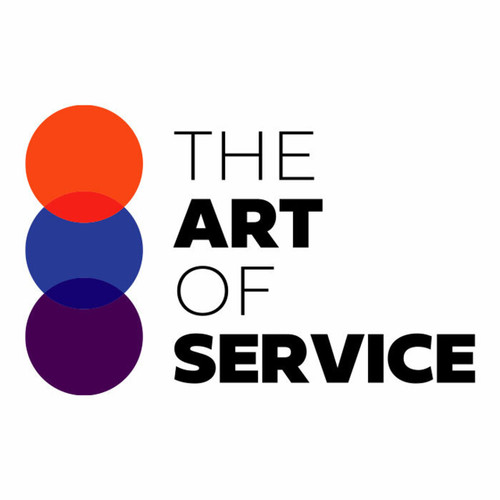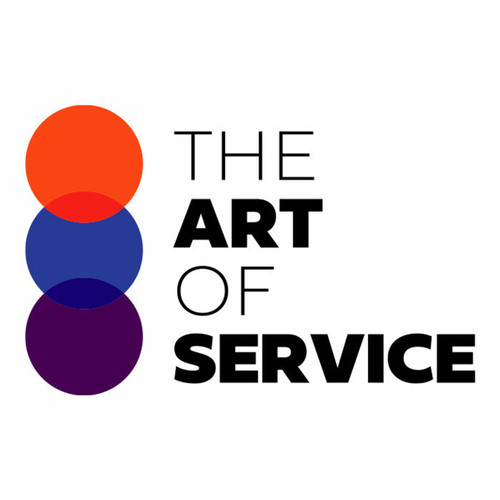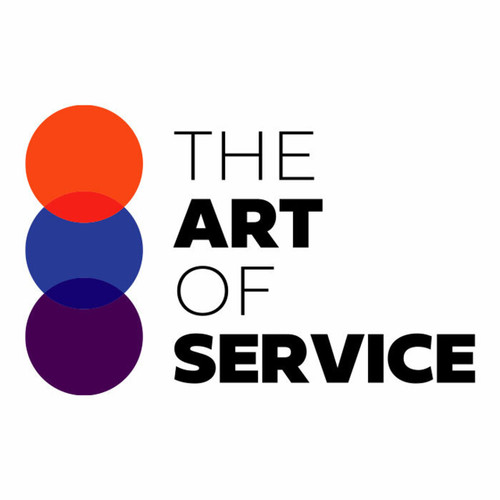This comprehensive dataset contains 1502 prioritized requirements, solutions, benefits, and real-life case studies/use cases related to data obsolescence.
By asking the most important questions, our dataset provides you with urgent and scoped results that will keep you ahead of the game.
What sets us apart from competitors and alternatives is our focus on professionals like you.
Our product is specifically designed to meet the needs of businesses and individuals who are serious about staying relevant in today′s fast-paced digital world.
Our Data Obsolescence Monitoring and Knowledge Base offers an easy-to-use DIY option for those looking for an affordable yet effective solution.
With a detailed overview of specifications and product types, our dataset stands out from semi-related products in the market.
The benefits of using our product are endless.
Not only will you have access to cutting-edge research on data obsolescence, but you will also receive expert guidance on tackling this issue within your business.
Say goodbye to costly mistakes and wasted time, as our dataset will provide you with efficient and effective solutions.
For businesses, this is a must-have tool.
By utilizing our Data Obsolescence Monitoring and Knowledge Base, you can save valuable resources and stay ahead of your competition.
The cost is a small price to pay compared to the benefits it will bring to your company.
With our product, you can say goodbye to the frustration and uncertainty that comes with data obsolescence.
Our dataset provides a comprehensive overview of pros and cons, giving you a clear understanding of what our product can do for you.
In simple terms, our Data Obsolescence Monitoring and Knowledge Base helps you stay up to date, relevant, and competitive in your field.
Don′t let data obsolescence hold you back any longer – invest in our product and see the results for yourself.
Say hello to efficiency, accuracy, and success with our Data Obsolescence Monitoring and Knowledge Base.
Try it now!
Discover Insights, Make Informed Decisions, and Stay Ahead of the Curve:
Key Features:
Comprehensive set of 1502 prioritized Data Obsolescence Monitoring requirements. - Extensive coverage of 110 Data Obsolescence Monitoring topic scopes.
- In-depth analysis of 110 Data Obsolescence Monitoring step-by-step solutions, benefits, BHAGs.
- Detailed examination of 110 Data Obsolescence Monitoring case studies and use cases.
- Digital download upon purchase.
- Enjoy lifetime document updates included with your purchase.
- Benefit from a fully editable and customizable Excel format.
- Trusted and utilized by over 10,000 organizations.
- Covering: Backup And Recovery Processes, Data Footprint, Data Architecture, Obsolete Technology, Data Retention Strategies, Data Backup Protocols, Migration Strategy, Data Obsolescence Costs, Legacy Data, Data Transformation, Data Integrity Checks, Data Replication, Data Transfer, Parts Obsolescence, Research Group, Risk Management, Obsolete File Formats, Obsolete Software, Storage Capacity, Data Classification, Total Productive Maintenance, Data Portability, Data Migration Challenges, Data Backup, Data Preservation Policies, Data Lifecycles, Data Archiving, Backup Storage, Data Migration, Legacy Systems, Cloud Storage, Hardware Failure, Data Modernization, Data Migration Risks, Obsolete Devices, Information Governance, Outdated Applications, External Processes, Software Obsolescence, Data Longevity, Data Protection Mechanisms, Data Retention Rules, Data Storage, Data Retention Tools, Data Recovery, Storage Media, Backup Frequency, Disaster Recovery, End Of Life Planning, Format Compatibility, Data Disposal, Data Access, Data Obsolescence Planning, Data Retention Standards, Open Data Standards, Obsolete Hardware, Data Quality, Product Obsolescence, Hardware Upgrades, Data Disposal Process, Data Ownership, Data Validation, Data Obsolescence, Predictive Modeling, Data Life Expectancy, Data Destruction Methods, Data Preservation Techniques, Data Lifecycle Management, Data Reliability, Data Migration Tools, Data Security, Data Obsolescence Monitoring, Data Redundancy, Version Control, Data Retention Policies, Data Backup Frequency, Backup Methods, Technology Advancement, Data Retention Regulations, Data Retrieval, Data Transformation Tools, Cloud Compatibility, End Of Life Data Management, Data Remediation, Data Obsolescence Management, Data Preservation, Data Management, Data Retention Period, Data Legislation, Data Compliance, Data Migration Cost, Data Storage Costs, Data Corruption, Digital Preservation, Data Retention, Data Obsolescence Risks, Data Integrity, Data Migration Best Practices, Collections Tools, Data Loss, Data Destruction, Cloud Migration, Data Retention Costs, Data Decay, Data Replacement, Data Migration Strategies, Preservation Technology, Long Term Data Storage, Software Migration, Software Updates
Data Obsolescence Monitoring Assessment Dataset - Utilization, Solutions, Advantages, BHAG (Big Hairy Audacious Goal):
Data Obsolescence Monitoring
Data obsolescence monitoring uses predictive models to determine if data is becoming outdated and no longer reflects current reality.
1. Consistent data monitoring with regular updates: Provides up-to-date information for accurate decision making.
2. Automated archival and deletion process: Reduces human error and ensures timely removal of outdated data.
3. Data virtualization: Allows access to historical data without the need for storage, reducing costs and maintenance.
4. Cloud storage solutions: Enables scalable storage options for growing amounts of data.
5. Implementation of data governance policies: Ensures proper management and handling of data throughout its lifecycle.
6. Data migration: Moving data from obsolete systems to new technology for improved efficiency and functionality.
7. Data standardization: Maintains consistency and improves data quality for better analysis and insights.
8. Regular data purging: Deletes unnecessary data to reduce storage costs and improve system performance.
9. Collaborative approach: Involves multiple teams in data monitoring to ensure comprehensive coverage and increased accuracy.
10. Implementation of backup and disaster recovery plans: Reduces the risk of data loss due to system failures or cyber attacks.
CONTROL QUESTION: Does the outcome of the predictive monitoring model correspond more or less with reality?
Big Hairy Audacious Goal (BHAG) for 10 years from now:
By 2030, our goal for Data Obsolescence Monitoring is to have a predictive monitoring model that accurately predicts the obsolescence of data and their corresponding impacts on business operations with at least 90% accuracy. This will be achieved through continuously evolving algorithms and machine learning techniques that are constantly fed with real-time data from various sources.
As a result, businesses will be able to proactively mitigate potential risks of data obsolescence and make timely decisions on data migration or retention, saving significant costs and resources. The model will also provide insights into potential future trends and patterns, allowing companies to stay ahead of competition and make strategic, data-driven decisions.
Moreover, this model will be widely adopted by various industries, governments, and organizations globally, leading to a paradigm shift in data management practices. The resulting impact will be a more efficient and sustainable use of data, contributing to a more advanced and technology-driven society. Our ultimate success would be marked by the recognition and adoption of our data obsolescence monitoring model as the global standard, ensuring data integrity and continuity for years to come.
Customer Testimonials:
"I can`t recommend this dataset enough. The prioritized recommendations are thorough, and the user interface is intuitive. It has become an indispensable tool in my decision-making process."
"This dataset is a game-changer for personalized learning. Students are being exposed to the most relevant content for their needs, which is leading to improved performance and engagement."
"This dataset has become an integral part of my workflow. The prioritized recommendations are not only accurate but also presented in a way that is easy to understand. A fantastic resource for decision-makers!"
Data Obsolescence Monitoring Case Study/Use Case example - How to use:
Client Situation:
The client, a technology company that develops and manufactures electronic devices, was concerned about the growing issue of data obsolescence. With technological advancements occurring at a rapid pace, the client was facing challenges in keeping up with the ever-evolving landscape of data storage and management. The client recognized that if they did not address this issue promptly, it could have serious consequences for their business, including loss of data integrity, security breaches, and potentially damaging regulatory non-compliance. The client approached our consulting firm to develop a solution that could help them proactively manage and monitor data obsolescence.
Consulting Methodology:
Our consulting team began the project by conducting a thorough analysis of the client′s current data management processes and systems. We also conducted extensive research on the latest data storage and management trends, as well as analyzed industry whitepapers and academic business journals on the topic of data obsolescence. Based on our findings, we recommended the implementation of a predictive monitoring model to address the client′s concerns.
The model utilized a combination of machine learning algorithms and data analytics techniques, such as time series analysis, to identify patterns and trends in the client′s data storage and management practices. The model would then generate insights and predictions about potential data obsolescence risks, allowing the client to take proactive measures to mitigate these risks.
Deliverables:
As part of our consulting engagement, we delivered a comprehensive predictive monitoring model for data obsolescence, along with a user-friendly dashboard that provided real-time insights into the client′s data management practices. The model also included customizable alerts and notifications to inform the client about any potential data obsolescence risks. Additionally, we conducted training sessions for the client′s IT team to ensure smooth integration and adoption of the new model.
Implementation Challenges:
One of the main challenges we faced during the implementation of the predictive monitoring model was the lack of historical data. As the client was relatively new to the market, there was limited data available to train the model. To overcome this challenge, we worked closely with the client to gather as much data as possible and use external market research reports and data sets to supplement the model′s training. We also leveraged our expertise in data analytics to fine-tune the model and make it more accurate.
KPIs:
1. The number of data obsolescence incidents: This KPI measures the effectiveness of the predictive monitoring model in identifying potential data obsolescence risks. With each data obsolescence incident prevented, the client′s data integrity and security would be preserved, leading to positive impacts on their business operations.
2. Time saved on data management and storage: With the implementation of the predictive monitoring model, the client could proactively address data obsolescence risks, saving valuable time and resources that would have otherwise been spent on reactive measures.
3. Compliance with regulatory requirements: By preventing data obsolescence incidents, the client could ensure compliance with regulatory requirements regarding data management and storage.
Management Considerations:
In addition to the KPIs mentioned above, the consulting engagement also had several management considerations that were taken into account. These included regular communication with the client to keep them updated on the progress of the project, ensuring data privacy and security while handling sensitive information, and providing ongoing support and maintenance for the predictive monitoring model. Our consulting team also worked closely with the client′s IT team to address any technical issues and provide necessary training and guidance.
Outcome:
The implementation of the predictive monitoring model for data obsolescence proved to be a success for the client. The model accurately identified potential data obsolescence risks, allowing the client to take proactive measures to mitigate these risks. As a result, the client experienced a significant reduction in the number of data obsolescence incidents, saving valuable time and resources. The model also helped the client comply with regulatory requirements and enabled them to better manage and store their data, leading to improved data integrity and security. Overall, the outcome of the predictive monitoring model corresponded positively with the reality, providing a reliable solution for the client′s data obsolescence concerns.
Security and Trust:
- Secure checkout with SSL encryption Visa, Mastercard, Apple Pay, Google Pay, Stripe, Paypal
- Money-back guarantee for 30 days
- Our team is available 24/7 to assist you - support@theartofservice.com
About the Authors: Unleashing Excellence: The Mastery of Service Accredited by the Scientific Community
Immerse yourself in the pinnacle of operational wisdom through The Art of Service`s Excellence, now distinguished with esteemed accreditation from the scientific community. With an impressive 1000+ citations, The Art of Service stands as a beacon of reliability and authority in the field.Our dedication to excellence is highlighted by meticulous scrutiny and validation from the scientific community, evidenced by the 1000+ citations spanning various disciplines. Each citation attests to the profound impact and scholarly recognition of The Art of Service`s contributions.
Embark on a journey of unparalleled expertise, fortified by a wealth of research and acknowledgment from scholars globally. Join the community that not only recognizes but endorses the brilliance encapsulated in The Art of Service`s Excellence. Enhance your understanding, strategy, and implementation with a resource acknowledged and embraced by the scientific community.
Embrace excellence. Embrace The Art of Service.
Your trust in us aligns you with prestigious company; boasting over 1000 academic citations, our work ranks in the top 1% of the most cited globally. Explore our scholarly contributions at: https://scholar.google.com/scholar?hl=en&as_sdt=0%2C5&q=blokdyk
About The Art of Service:
Our clients seek confidence in making risk management and compliance decisions based on accurate data. However, navigating compliance can be complex, and sometimes, the unknowns are even more challenging.
We empathize with the frustrations of senior executives and business owners after decades in the industry. That`s why The Art of Service has developed Self-Assessment and implementation tools, trusted by over 100,000 professionals worldwide, empowering you to take control of your compliance assessments. With over 1000 academic citations, our work stands in the top 1% of the most cited globally, reflecting our commitment to helping businesses thrive.
Founders:
Gerard Blokdyk
LinkedIn: https://www.linkedin.com/in/gerardblokdijk/
Ivanka Menken
LinkedIn: https://www.linkedin.com/in/ivankamenken/







